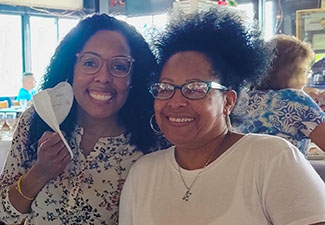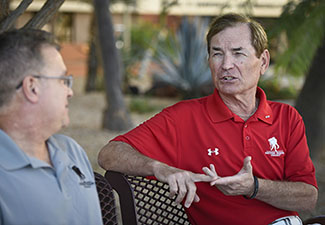A Veteran’s Path from Alcohol and Addiction to Advocacy and Awareness

Raymond Andalio was no stranger to pressure. As a Navy hospital corpsman, his mission was to care for fellow service members in the field. But when a series of explosions nearly ended his life, everything changed.
He woke up days later in a trauma unit, with no memory of how he became the patient. But he vividly recalls what came after — the loss of brotherhood, the loneliness, and the feeling of being invisible.
Ray found solace in drugs and alcohol. But with help from his family, other veterans, and support from Wounded Warrior Project® (WWP), Ray was able to overcome his addictions, find a new sense of purpose, and heal.
The Price of Freedom
Ray immigrated to the United States at 14 years old, after a revolution forced his family to flee their home in the Philippines. Grateful for the country that gave his family safety and freedom, Ray wanted to give back. In 1992, he joined the U.S. Navy and served six years on active duty before transferring to the reserves.
In 2003, Ray who had been trained as a hospital corpsman, was embedded with the 2nd Battalion, 23rd Marine unit during Operation Iraqi Freedom. Known as “Doc” to the Marines he served alongside. Nearly every day, Ray made life-and-death decisions in the field, under fire.
“We were our own doctors in the field. The whole battalion was getting blasted left and right, and there were lots of injuries,” recalls Ray. “We had other Marines protecting us, but we had to decide — do you put a Band-Aid on and send them back to fight, or are they dying in your arms?”
When the Doc Becomes the Patient

In April 2003, Ray found himself on the other side of the bed. The details are still blurry, but a series of explosions ripped through the area where his company was positioned.
“I didn’t even know what happened. The next thing I know, I’m on a gurney, and the bird that’s flying me out is getting shot at,” recalls Ray.
“I woke up in a trauma unit where they told me I was lucky to be alive.”
Ray sustained a traumatic brain injury (TBI), a serious condition caused by a sudden blow or jolt to the head.
The TBI Center of Excellence reports that more than 515,000 military personnel were diagnosed with a TBI between 2000 and 2024. According to Wounded Warrior Project’s most recent Warrior Survey,* 35% of veterans surveyed reported experiencing a brain injury as a result of their military service.
When Wounds Are Hard to See
After coming home, Ray tried to settle back into a normal life. But he struggled to find acceptance and cope with the side effects of the TBI and post-traumatic stress disorder (PTSD), which were not as well-known at the time.

The weight of survivors’ guilt made things even harder.
“As a corpsman, you’re there to save lives — but the reality of war is that you can’t save everyone,” Ray says.
He adds that offering emotional support was part of his job, too, which meant carrying others’ trauma as well as his own.
“I was their counselor, their brother, the guy who knew all the secrets. And I was supposed to be OK.”
In 2008, Ray medically retired from the military.
Wanting a fresh start, Ray tried to find a job in a hospital, thinking his medical experience would be an asset. Instead, they turned him away.
“I’d just come back from the war. They looked at me like I was broken … they didn’t want me.”
He tried returning to school, but the TBI made it nearly impossible to focus and retain information. Ray’s brain injury also affected his optic nerve, and without special glasses, it would cause debilitating headaches. He struggled to fall asleep, and when he did, nightmares haunted him.
I didn't want to die. I just didn't want to wake up anymore.
Ray turned to alcohol and drugs to quiet the chaos in his mind and numb the pain.
The Descent into Addiction
Living in Las Vegas, Ray took a bartending job at a popular club, partly because it gave him easy access to the temptations available on the strip.
“I had been one in a unit of 20 Marines. Now I was just one out of millions of people. I had become invisible, so I chose that life so nobody would see me,” he said.
Ray drank to forget and used cocaine to stay numb. He worked nights and slept through the days, avoiding his family and himself.
“I didn’t want to be seen. I didn’t want to die. I just didn’t want to wake up anymore.”
It’s common for veterans to use substances to manage emotional pain. Data from WWP’s Warrior Survey* shows 60% of warriors use alcohol, non-prescription marijuana, or narcotics to help with feelings of stress or mental health concerns. Nearly half of those surveyed showed signs of hazardous drinking or alcohol use disorders.
A Fight for His Life
For Ray, it wasn’t a single moment that changed his outlook, but a series of them. One included the loss of his job.
After that, Ray knew he needed help.
I'm still Doc, even though I don't carry bandages anymore. I am still able to help people.
With support from his wife, Deedra, he moved to San Diego and checked into a VA hospital to begin the long process of detoxing and understanding his wounds. Deedra remained by his side, serving as his caregiver and cheerleader.
Despite seeking help, learning to live with a TBI and PTSD brought challenges. “There were days I still didn’t want to wake,” Ray admits.
Finding Strength in Brotherhood
It was after a conversation with a fellow veteran, Shane “Crutch” Crutchinson, that Ray says his perspective changed.
“He told me, ‘Doc, we still need you in the field. That hit me. I was tired of being angry. Tired of being ashamed. I realized I wanted to live, that I still had something to give,” says Ray.
Crutch introduced Ray to WWP™, and finally, his life started to improve.

Ray welcomed the chance to join various activities, including Project Odyssey®, an adventure-based mental health program that helped him build resilience and gain self-awareness.
He also found comfort in movement, particularly running and cycling. He’s participated in Soldier Ride® events and competed in more than a dozen marathons worldwide. Ray also embraced what he calls “wind therapy” — hitting the open road on his motorcycle and letting intrusive thoughts go.
“When I came back from the war, several of us corpsmen made a pact to get Harley-Davidson motorcycles and ride together,” says Ray, adding that in 2015, he was one of several warriors who were gifted a motorcycle by Harley-Davidson to commemorate its partnership with WWP.
“It was such a blessing and it gave me purpose,” recalls Ray. “When I’m on the bike, that’s the time I feel free. But the motorcycle is also my vessel to connect with those who need support.”
In connecting with others, Ray found a new brotherhood and healing.
The Role of Family, Faith, and Creativity
Healing doesn’t happen overnight. It takes patience, courage to face difficult moments, and a solid support network.
In addition to WWP, Ray credits his wife for helping save his life. “She’s my savior,” he says.
Married for nearly 30 years — though they separated for a time during Ray's darkest days — the couple shares two grown sons and a commitment to sobriety.
Ray is celebrating 14 years sober, and Deedra is now seven years sober. Their shared journey has only strengthened their relationship.
“We both drank. We both partied. But we both chose to live,” he says. Today, his go-to drink is a cold can of sparkling water.
To support their healthier lifestyle, the couple moved to Oklahoma, where Ray finds peace in nature and embraces mindfulness practices.
“I had to learn how to be in my own skin again. I had to learn how to breathe,” he recalls, adding that he reads his Bible and practices meditation daily.
While he still has days when pain disrupts his plans, Ray is thriving. He can often be found in his home workshop, creating moulage (hyper-realistic mock wounds) for military training and crafting leather saddlebags, wallets, and holsters.
Interestingly, he doesn’t sell his work. “I give them away. Because when I see someone using something I made, it reminds me I still have something to offer,” he says.
Ray also launched a nonprofit that teaches warriors valuable trade skills, such as gardening, motorcycle repair, and welding. He hopes to host equine therapy and outdoor adventure retreats in the future.
“I want to teach [warriors] that everything is fixable. You just need the right tools,” he says.
‘I Am Still Doc’

Today, Ray serves as a WWP Peer Support Group leader and volunteer speaker, reminding others that PTSD and other war injuries don’t mean it’s the end of life. It’s just the beginning of a different one.
“Wounded Warrior Project gave me a platform to tell my story. And in telling it, I started to understand it,” he says. “Thanks to Wounded Warrior Project, I’m still ‘Doc,’ even though I don’t carry bandages anymore. I am still able to help save people. I’m just doing it differently now.”
Earlier this year, Ray joined forces with motorcycle influencer Adam Sandoval and Harley-Davidson on a cross-country trip dubbed the “Great American Convoy” to raise awareness of and funds for veterans’ needs. Since 2013, the “Great American Convoy” has raised nearly $1 million to support WWP.
But Ray says the ride isn’t just about moneyIt was about showing up and reminding people we’re still here. There’s a light at the end of the tunnel. You’re not alone. You still have a team.”
* Warrior Survey, Wave 3 (conducted June 15-Aug 24, 2023)
Learn more about how WWP can support you in improving your physical health and mental wellness.
Contact: Cynthia Weiss – Public Relations, cweiss@woundedwarriorproject.org, 904.738.2589
About Wounded Warrior Project
Wounded Warrior Project is our nation’s leading veteran services organization, focused on the total well-being of post-9/11 wounded, ill, or injured veterans. Our programs, advocacy, and awareness efforts help warriors thrive, provide essential lifelines to families and caregivers, and prevent veteran suicides. Learn more about Wounded Warrior Project.


